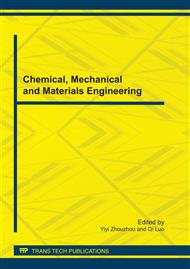p.270
p.276
p.282
p.288
p.293
p.298
p.304
p.309
p.318
Isolation and Screening of Acetochlor-Degrading Strain and its Degradation Characteristics
Abstract:
The acetochlor residue in the tobacco cultivated soils was inclined to affect the growth of tobacco. In this study, regarding the acetochlor as the inorganic salt medium with the sole carbon source, we obtain the acetochlor-degrading bacteria from the tobacco cultivated soil through isolation and screening, numbering as CSUFTM78. Under the view of the microscopy, the bacteria has a rod shape and no spore with the size of 0.8 ~ 1.5 × 0.4 ~ 0.6μm; in the medium, the colonies are opaque, white, round, convex with neat edge and moist and shiny surface. Then determine the concentration of acetochlor which was directly added into the liquid medium and the phote-absorbance of strain number using UV spectrophotometer. The results indicate that the strain CSUFTM78 can grow in the inorganic salt medium which regards quinclorac as the sole carbon source; besides, the degradation rate was up to 38%. By determining the 16S sequence of CSUFTM78 strain, the homology of GENBANK in BLAST reaches more than 99% with Stenotrophomonas maltophilia (HQ185399). By constructing a phylogenetic tree, strain CSUFTM78 and S. maltophilia were integrated into one with the confidence of 100%. Combined with the morphological characteristics of strains, we identify the CSUFTM78 as S.maltophilia and the results can provide both strains and theoretical basis for degrading the acetochlor residual in tobacco cultivated soil using microorganism.
Info:
Periodical:
Pages:
318-323
Citation:
Online since:
July 2011
Authors:
Price:
Сopyright:
© 2011 Trans Tech Publications Ltd. All Rights Reserved
Share:
Citation:


